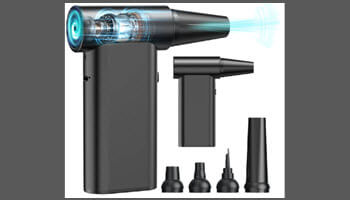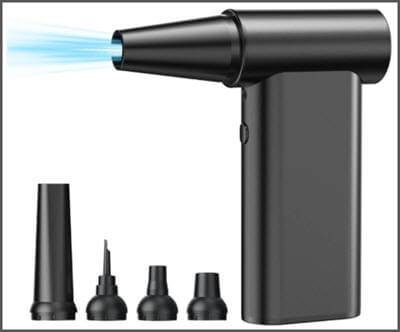For years now, I’ve always kept two or three air duster cans of compressed air in stock for cleaning up clients’ machines as well as my own. Maybe I’m late to the party, but a few months ago I came across these rechargeable electronic air dusters and was interested enough to purchase one.
This is the electronic air duster I bought:
“Designed for powerful cleaning with a turbo jet fan, this cordless and portable device features a high-quality motor and multiple blowing nozzles for versatile applications“.
The brand is “Karuza”, which I believe is an Australian company, but there are plenty of similar devices available in all countries. Most of these devices come with three speeds, the Karuza achieves 45,000 rpm at low speed through to 120,000 rpm at its fastest speed. Most also come with an array of nozzles suitable for various functions. The Karuza cost me $59.00AU. However, there are plenty of models to choose from in the US, ranging from $40.00US to $90.00US.
The Karuza comes with a brushless motor and 2 x 4000mAh batteries, providing plenty of dusting time and with a 2-hour charging time from dead flat. These devices are available in faster speeds, up to 300,000 rpm, and at first I was concentrating on models that achieved those faster speeds. However, in the end I decided on the Karuza because it is local and through an online store that I have dealt with previously and trust.
Speed Doesn’t Matter
As it turns out, the speed (maximum rpm) is not a major concern. I have used this little air duster multiple times and have never needed the maximum 120,000 rpm. Most of the time, I’ve used its lowest speed (45,000 rpm), which has proved more than adequate. So, if you’re looking at buying one of these devices, I suggest you concentrate more on build quality rather than maximum rpm.
Admittedly, when buying online without any hands-on access, it is difficult to judge build quality. However, in most cases you should get some idea from user reviews.
BOTTOM LINE:
For most average home users the old standard can of compressed air will likely do the job. However, if you are the go-to-PC-person among your group of family and friends, I strongly recommend buying one of these portable rechargeable electronic air dusters. I guarantee you’ll be amazed at how powerful they are and you’ll save money in the long run.
Plus, of course, you’ll avoid that situation where you need to clean up a PC only to discover that your last remaining can of compressed air is near enough to empty.
—


Another good article, Jim. The question sometimes comes up as to the adverse effects these might have on laptops, such as pushing dust into or onto components that possibly won’t like it too much, or causing the fans to spin so high that it could break them. Is that hype or is legit? Any suggestions as how and then how often to use them, especially the canned air?
Hey Nicke,
I’m not sure one of these would be ideal for laptops, I only use it on desktop PCs. Yes, it’s true that one has to be careful with internal fans, I usually just apply a piece of tape between the fan blade and housing prior to cleaning.
As for frequency, that’s entirely up to the individual. Most machines I receive for repairs haven’t been cleaned for ages. However, I clean my own machines twice a year.
Thanks Jim for your reply. I’ve never had a problem with dust inside laptops over the years, though I “very” periodically use canned air but cautiously and half afraid to do so because of the fans.
Your articles are always interesting & appreciated.
Nicke, I have a vacuum attachment kit, that uses small brushes, nozzles and tubing for cleaning keyboards and dust in desktops before and after blowing the dust. You can also try using Q-tips to reach between the keys, Mindblower!
Hi Jim – word of warning from an old fart who reads a lot.
Do not use these high powered blowers directly onto your GPU fans without at least stopping the blades from spinning. By spinning the fan with the blower you create reverse electricity like a turbine – enough to potentially damage your card especially the modern very expensive ones. I am guessing that the same could potentially apply to any other fans attached to a system. If you must blow the fan blades immobilise the fans first so they can’t spin. Apart from that there is nothing more satisfying that watching clouds of dust erupt from a PC. Just don’t do it indoors like I did unless you want a divorce !
Cheers
Reg
My apologies – I see you covered this in a previous comment….
No problem Reg. It’s a warning that bears repeating.